-
Posts
153 -
Joined
-
Last visited
Content Type
Profiles
Forums
Blogs
Gallery
Events
Store
Posts posted by Jonathan Hopkins
-
-
I have had this medallion for quite a while (approximately 1.5" in diameter), but have never know much about it other than the obvious (that it commemorates the victory at Talavera). Was it a part of a set? When were these medallions made? Are they rare? Any insights would be much appreciated!
Thank you,
Jonathan

 0
0 -
Hi Mervyn,
I don't recognise the pattern, but the profiled grip, cut-out indentation in the guard for the tumb-tip and the sword knot are all very Italian features!
John
Mervyn,
It is definitely Italian, but I am not sure what pattern. It appears to be a mix of two patterns; the guard of an M1929 Infantry NCO sword:
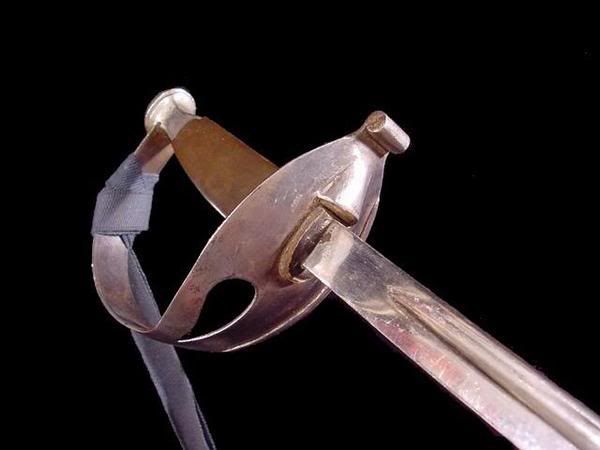
And the grip of an M1888 Artillery sword:
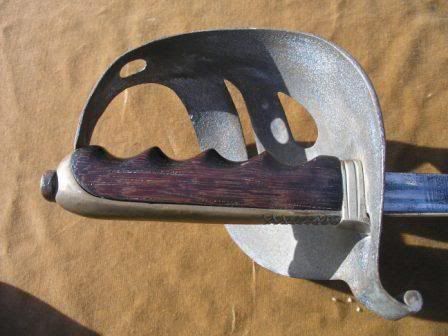
I cannot cite a reference, but I have been told that some WWII era Italian swords were put together from elements of various models to sell to allied soldiers as souvenirs. I am not sure how true that is, though.
Jonathan
0 -
Mervyn,
I am not sure when Wilkinson used "to the Queen". As far as I know they used "by Appointment" to the Price of Wales for quite a long time. I will look into that and get back to you.
The sword has been cleaned. I don't think that there is much visible difference that I would be able to capture with photos. The rust is gone, the grip is less dirty, but other than that, the scabbard is still dark with age, and the blade is still nice--not pitted but not in like-new condition. After all, I like my antiques to look like antiques!

Jonathan
0 -
Excellent topic, Mervyn.
 Do you know what Zulu spears were supposed to have looked like before this type developed? Do you know anything about their production? How is the shaft attached?
Do you know what Zulu spears were supposed to have looked like before this type developed? Do you know anything about their production? How is the shaft attached?Jonathan
0 -
Richie,
Thank you for your reply. I am enamored with the sword and really enjoyed researching the officer! My wife caught me in the act of photographing the sword on Saturday:
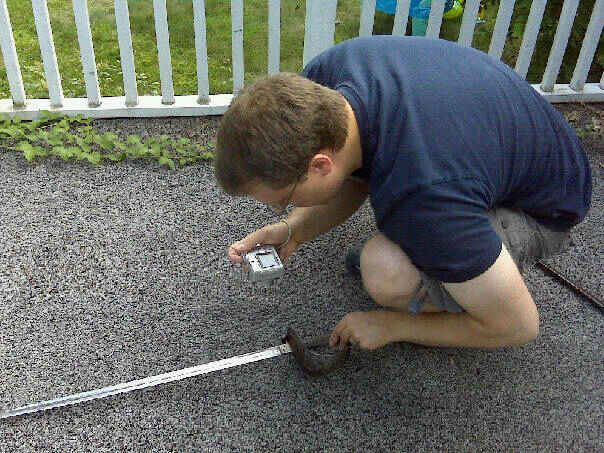
Mervyn,
Thank you for your kind words. I will probably just clean it off with some Break Free CLP with an old tooth brush and paper towel. This helps dislodge dirt and grime, and also active orange rust. Once I am satisfied that the sword has been stabilized, I will wipe off the Break Free and then wipe the sword with a silicone-impregnated gun and reel cloth. This will protect the metal, and I will follow up at least once a month by wiping it with the gun and reel cloth. I try not to do anything that cannot be easily reversed.
Jonathan
0 -
I have yet to address some grime and active rust. I was too excited to post the sword and do the write-up, so I put the task of conservation off for a day. I will post some "after" pics if there is a noticeable difference. Here are some additional images that would not fit into the previous post:


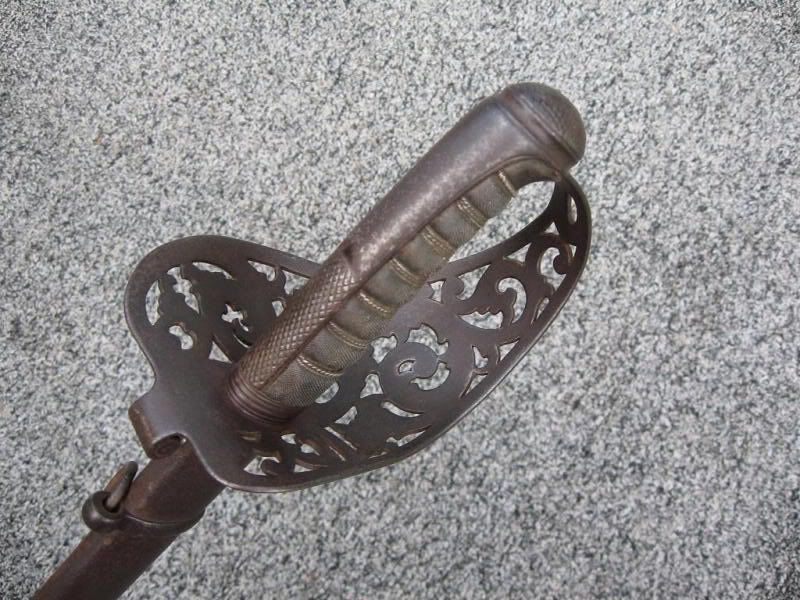


 0
0 -
In March of 2008 I decided that I wanted to take my collection in a new, more focused direction. Soon after making this decision I was able to buy a nice Pattern 1897 Infantry Officer’s Sword to an officer of the Indian Army. Researching his life and career sparked an interest in the Indian Army and the various campaigns in the North West Frontier and Afghanistan. I decided to further narrow my collecting efforts to Indian Army officers’ swords. After that initial purchase, however, I struggled to find swords which fit into my framework, and when I did they were out of my price range, or scooped up by other collectors. I was able to satisfy my interests in India, the NWF, and Afghanistan by pursuing swords of officers of the British Army who served in my region of interest. Now, just about a year and a half later, I have had the good fortune of finding a sword to another officer of the Indian Army, and better yet, a special pattern favored by officers in India.

Originating from John Jacob of the Scinde Horse, the scroll hilt (or acanthus hilt) is best known for its brass incarnation in the form of the British Pattern 1857 Royal Engineers Officer’s Sword. But well before 1857 a steel version was favored by officers serving in India, and continued to be produced for discerning officers of both the British and Indian Armies who wanted good fighting swords. My sword, serial number 13539, was made in 1865 for Captain Richard Topham of the 16th Bengal Cavalry. The 1 lb. 14 oz. sword is an excellent example of a weapon intended for service. The steel guard is engraved with an acanthus leaf design. The rest of the weapon is rather Spartan in design. Aside from the standard Wilkinson Pall Mall, and the proof disc, the only blade decoration is the officer’s family crest. The rest of the 34 ¼†blade is plain, and has been sharpened for service. The sharpening begins 8†from the guard and continues to the tip, while almost 7†of the false edge has been sharpened. The scabbard is steel with a German silver mouth, and the inside is lined with wood.




Richard Topham’s first commission was as an ensign in the Royal Lancashire Militia (1st March, 1855). Soon thereafter, he was promoted lieutenant (June, 1855). In July of the same year, he purchased his first regular army commission as a cornet in the 4th (The Queen’s Own) Regiment of Light Dragoons. Less than one year later, on 14 March 1856, Topham was promoted lieutenant (without purchase). At some point in 1857 he transferred top the 7th (The Queen’s Own) Regiment of Light Dragoons (Hussars) and embarked for service in India. Topham served with distinction during the Indian Mutiny (also known as India's First War of Independence, the Great Rebellion, the Indian Rebellion, the Revolt of 1857, the Uprising of 1857 and the Sepoy Mutiny). The Hart’s List for 1860 records:
Lieut. Topham served in the Indian campaign from Feb. 1858 to March 1859 and was present at the repulse of the enemy’s attack on the Alumbagh, siege and capture of Lucknow, affairs of Barree (wounded) and Sirsee, action of Nawabgunge (contused), occupation of Fyzabad, passage of the Goomtee at Sultanpore, throughout the Byswarra campaign, including the affairs at Kandoo Nuddee, Paleeghat, and Hyderghur, and pursuit of Benhi Madhu's force to the Goomtee; also the Trans-Gogra campaign, including the affair near Churda and pursuit, taking the fort of Meejeedia , attack on Bankee with pursuit to Raptee, advance it to Nepaul and affair at Sitkaghat (twice mentioned in despatches, Medal and Clasp).Topham’s mentions in dispatches are recorded in the London Gazette:
Gazette Issue 22143 published on the 25 May 1858:
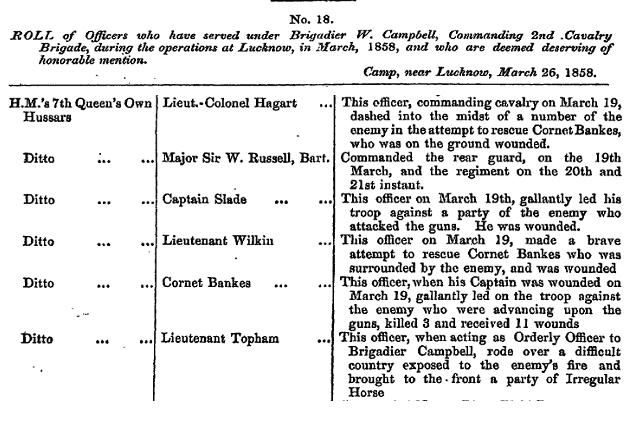
Gazette Issue 22259 published on the 5 May 1859:

And his actions in the field are recorded in several texts, including The Life of General Sir Hope Grant with selections from his correspondence:
On the 13th April we marched at daybreak, but had scarcely gone three miles on our way when I heard the advanced - guard commence firing. The road, or rather track, had been very bad, and I had remained behind to see the heavy guns brought across a nullah. I immediately galloped to the front, and found that a strong cavalry picket of the enemy had attacked our advanced- guard—had surrounded a troop of Wales' Horse, wounding one of the officers, Prendergast1 — and would have taken the two guns which were with it,—when they suddenly perceived a squadron of the 7th Hussars, which the dust had hitherto prevented them from seeing, ready to charge them, whereupon they wheeled about and galloped off. When I reached the scene of the conflict I saw this hostile force, which now amounted to some thousand men, working round our right flank, evidently bent on attacking our baggage, which extended over a line of nearly three miles. I instantly brought up 300 cavalry and two of Mackinnon's guns to protect our flank, and fired several shots at them, but without effect. In addition to our rear-guard, I ordered the Bengal Fusiliers to cover our right flank. I sent a troop of the 7th Hussars to patrol along both flanks, and another squadron to watch the movements of the sowars. The enemy came round in rear of a village, and were in the act of charging upon our baggage when the troop of the 7th Hussars, who were ready prepared for them, dashed down and galloped through them, putting them .to flight and sabring many of their number. Captain Topham, who commanded the troop, and who had run a native officer through the body, was wounded by a lance. He had two men mortally, and six men slightly, wounded. A little after, another body of the rebels charged down upon our baggage, but were met by two companies of the Bengal Fusiliers, who poured a volley into them when within 30 yards distant, which rolled a number in the dust. Thereupon they desisted from further attacks, and retreated as quickly as possible. The infantry were then ordered to advance. The enemy occupied a village on a hill in front of us, at the base of which a stream flowed. Large columns were posted on both sides of this valley. I threw out the Rifle brigade in skirmishing order, supported by the 5th Punjab corps. The main line in rear advanced close up to the village under a heavy fire and stormed it gallantly, capturing two colours. We afterwards advanced and took the higher ground, the rebels bolting without firing a shot. The cowardly fellows might, with a little resolution, have defended the position.Following the Mutiny, Topham remained in India and was attached as commandant to the 16th Bengal Cavalry in 1860. Topham purchased his captaincy 16 October 1863. In 1865 Topham officially transferred to the Bengal Staff Corps, and the occasion merited the purchase of his scroll hilt sword. He continued to serve as commandant of the 16th Bengal Cavalry—a position he would keep for the remainder of his career.
Topham’s next and final active service was during the Black Mountain (sometimes called 1st Hazara) Expedition of 1868. He would have carried his new scroll hilt during this campaign. Topham ably commanded his regiment and was mentioned in despatches for his service (William Henry Paget , A Record of the Expeditions Undertaken Against the North-West Frontier Tribes):
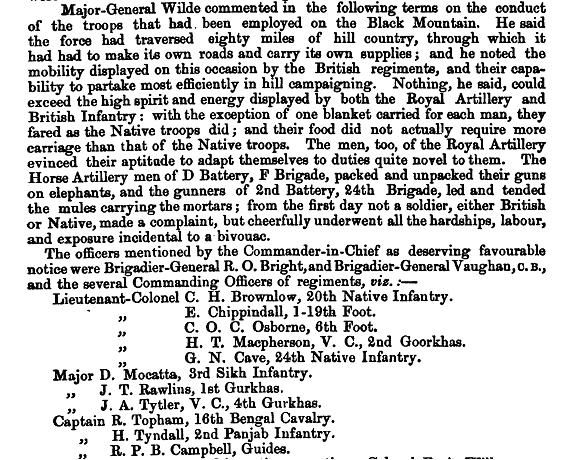
He received further commendations, as well:
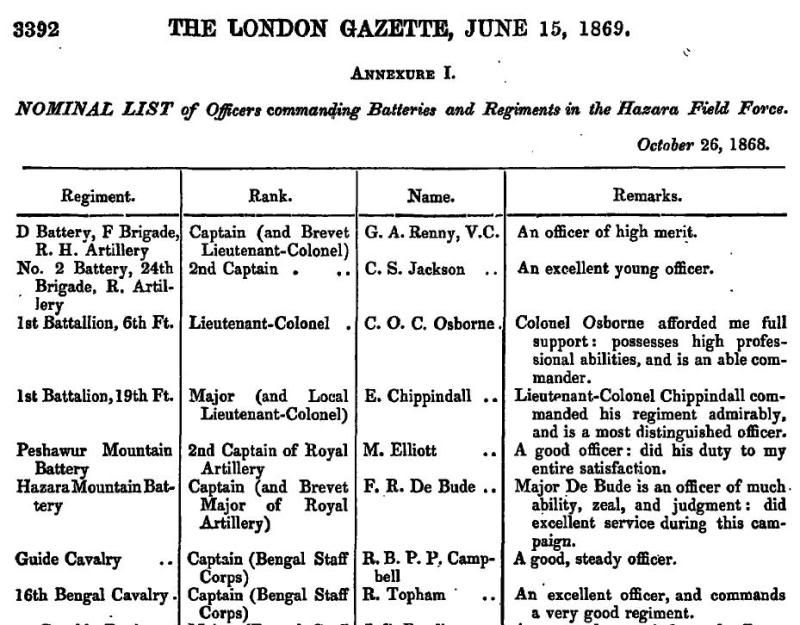
The remainder of Topham’s career appears to have been relatively quiet. He continued to command the 16th Bengal Cavalry:
Parliamentary Papers, 1877:

Topham was promoted Major on 27 July 1875. Sadly, he died the following year while his regiment was station in Bareilly. I have not been able to determine his cause of death, but cholera seems a likely suspect as there was an outbreak in Bareilly just before he died.
Based on the regiments with whom Topham served, he was probably quite familiar with special patterns and may have owned several throughout his career. The 4th Light Dragoons carried a variation of the scroll hilt which feature their regimental device (see Stephen Wood’s “Swords for the Crimea: some Scottish officers’ swords manufactured for Britain’s war with Russia 1854-56â€, Journal of the Arms and Armour Society, London, Vol. XVIII, No. 3, pp 115-135.) In addition to the individual flair of his previous British regiments, Topham would have been influenced by the fashion and preferences of officers of the HEIC and Indian Armies (see Graeme Rimer’s “The swords of John Jacobâ€, Royal Armouries Year Book 2, 1997), which probably led to the purchase of his final fighting sword.
0 -
British special pattern sword with scroll hilt (a.k.a., acanthus hilt) made by Wilkinson in 1865 for an officer of the 16th Bengal Cavalry. Write-up to follow later in a separate thread.



 0
0 -
That's great Jonathan - so he was trapped in Ladysmith with the Natal Naval Contingent. Would rather have his medals than the sword - a rare unit. Thankyou.
His medals could be worth more than the sword, I suppose. That is often the case. However, whether or not his sword was used or even worn during the conflict, it may have at least been in the city with him. In that sense, it was there, while the medals were not. For me that is the appeal of swords over medals. The swords witnessed history, while the medals were awarded after the fact.
Jonathan
0 -
Here is a topic from another forum that you may find informative:
http://forums.swordforum.com/showthread.php?t=83957&highlight=hospital
0 -
Hi Thomas,
Have been up to local library and found, John Wilkinson Latham, British military Swords From 1800 to Present Day. Page 40, describes this sword as being issued to Medical Staff-sergents
prior to 1865. After this they were required to carry a sword bayonet. It was referred to as a "drummers sword".
Steph,
Well done going to the library. That is a step most people skip, unfortunately. Books really are a key ingredient to understanding and further knowledge in this field. If your library has a copy of Swords of the British Army by Brian Robson, that is teh standard text on the subject. The Wilkinson-Latham book has some unique photos and illustrations, but the text is quite outdated.
Jonathan
0 -
The original Coast Guards sword was not an official pattern, to my knowledge. According to Robson (Swords of the British Army), these were adopted for other ranks of the Army Hospital Corps around 1861. Going back to Steph's original photos, her sword has a much more dramatic curve than the AHC swords usually exhibit. That could mean that hers is a variant, a Coast Guards sword (which had a more curved blade), or that it is the Indian pattern I referred to earlier
Jonathan
P.S. Steph, I will send you a PM. :)
0 -
I found this at angloboerwar.com:
Kenny, Signalman D C. QSA (3) DoL Tr LN
0 -
Mervyn,
It is possible that the sword was retailed through a local tailor or outfitter and that the etching was done by them, hence the poor quality of the name.
Jonathan
0 -
I think that it is quite likely brass or a related alloy of some sort. I do not suggest polishing the sword, but if it is dirty or if there is active rust I would address those problems. There is an excellent article on sword conservation here:
http://swordforum.com/articles/ams/conservation.php
As to the origin, I thought I had mentioned it but I guess I dod not. It is a British sword.
Jonathan
0 -
Mervyn,
Thank you for posting this nice sword. I think Hobson were a quality firm, but the etching is not up to Wilkinson standards, in my experience. The name etching seems particularly sloppy. Here is a Hobson P1897 that used to be in my collection. It belonged to EDMOND GRAY STUART TRUELL, who graduated from the Royal Military College on 7 May 1898. This date would be perfect timing for this officer to have purchased the sword. Truell was later assigned to service with the Mounted Infantry in S. Africa and the Connaught Rangers:

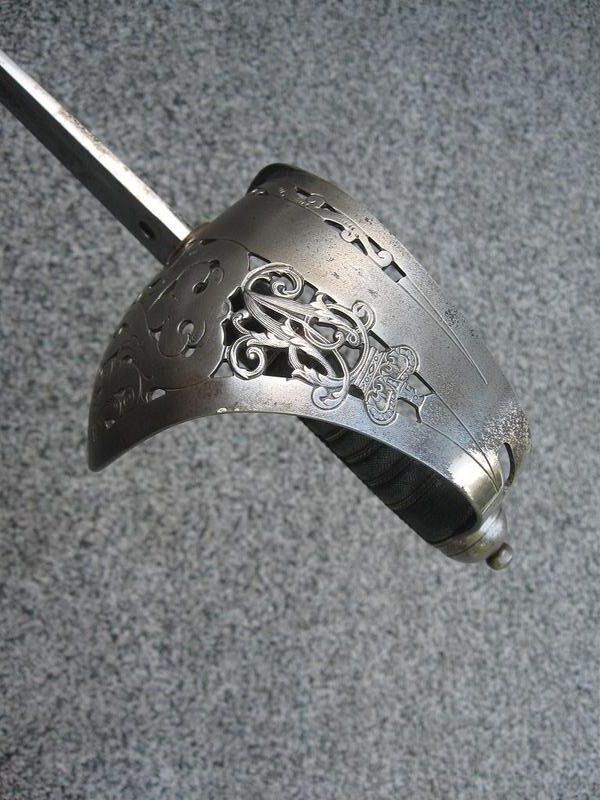
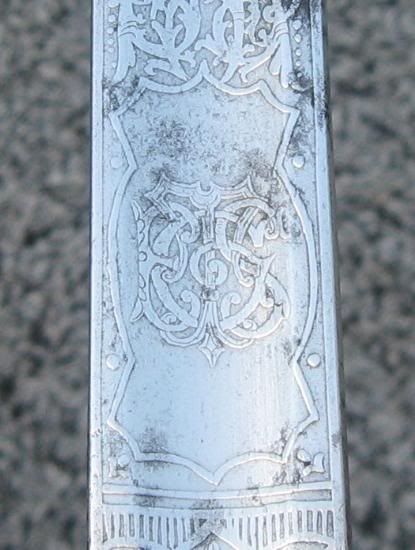
I will see if I can find anything more on your man, Kenny.

All the best,
Jonathan
0 -
Here is an example of the cast iron grip. Its paint has probably been polished away at some point (photo from oldswords.com):
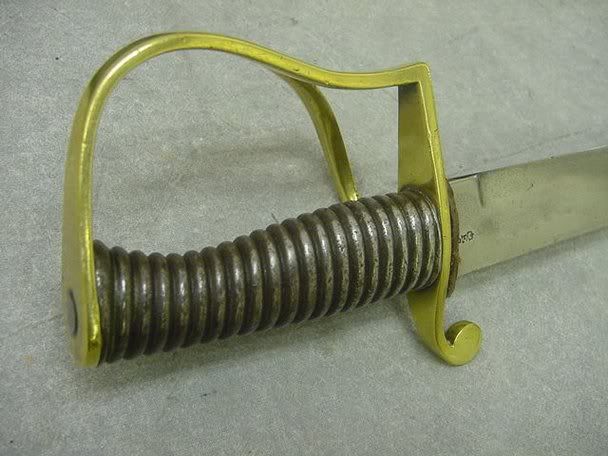 0
0 -
Hi Peter,
The hand grip is wood.
Steph
That is surprising. These swords generally have iron grips.
And sorry, but I do not have any idea as to the value. If you want to contact a UK dealer for a valuation I can give you contact information via private message.
0 -
Jonathon
I was intrigued by your reference to the Indian Army. I used to know a bit about them but I can't recall ever seeing a 'two bar hilt' on an Indian-worn sabre. One possible exception is a not very clear picture of a trooper of the Bengal Horse Artillery in an 1852 water colour (artist unknown. It seemed to me that most swords & sabres were either a copy of what the British Army was wearing at the time or native tulwars. Can you point me to a reference or illustration, please? Thanks
Peter
Peter,
See the photo of the seated bugler on page 10 of the Osprey title Indian Infantry Regiments 1860-1914:
http://books.google.com/books?id=0fYAZL_HrMQC&pg=PA3&dq=indian+army+1860-1914&ei=oep6SsfyG5mSywSh2fDEDA&client=firefox-a#v=onepage&q=indian%20army%201860-1914&f=false
I am not sure how similar the blades are, but the hilts are the same.
Jonathan
0 -
Steph
Is the hand grip wooden on this piece? I just noticed that it looks as if it might be, which I think is unusual for British swords. Or is it just very old black leather and missing the wire wrap?
Peter
The grip should be made of iron.
0 -
Hi can anyone help identify this old sabre found in the attic of an old farmhouse in Wales.
This pattern was in use in the first half of the 19th century, and was a sidearms for customs or the coast guard (or some such service--my memory is fuzzy without a book in front of me!), and later in the 19th century it was used by other ranks of the Army Hospital Corps. A similar sword was also used by buglers in the Indian Army of the Raj. Are there any markings on the sword or scabbard?
Jonathan
0 -
Mervyn,
I like that one very much!
 I have not see one with an "apron". Thank yo for posting it! Do you have any other sword accessories you could share?
I have not see one with an "apron". Thank yo for posting it! Do you have any other sword accessories you could share?Thank you,
Jonathan
0 -
Helen,
I recommend posting this in the Antique & Military section at swordforum.com or at myarmoury.com. There are a good number of people at those venues who study renaissance swords.
Jonathan
0 -
You could also post this in the Middle East & Africa section at Sword Forum International.
0



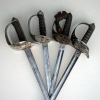
Duke of Wellington/Talavera bronze medallion
in Great Britain: Militaria: Badges, Uniforms & Equipment
Posted
Mervyn,
THANK YOU!!! I had forgotten all about this medal until a recent visit to my mother's house. I bought it years ago before the internet became the resource it is today. The link you provided has just the sort of information I was after. I am not sure what the value would be, but certainly worth the $40 US I spent on it in the mid-1990s.
Jonathan